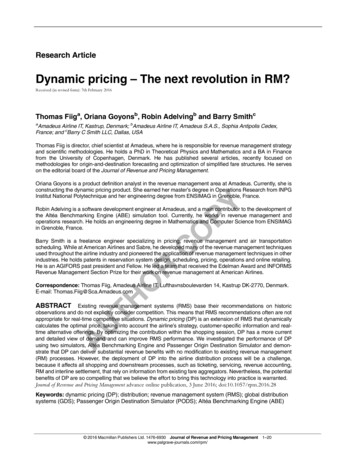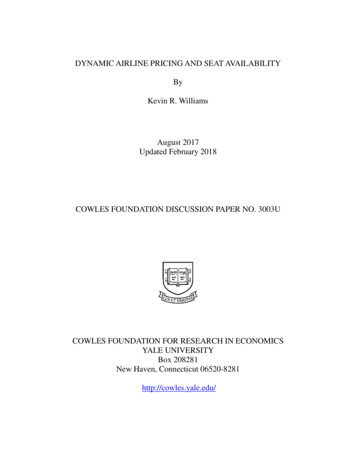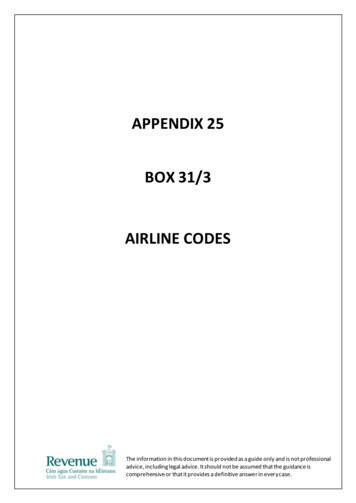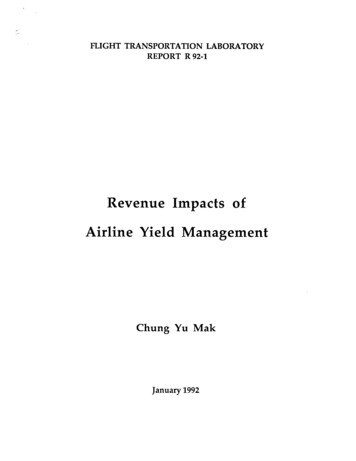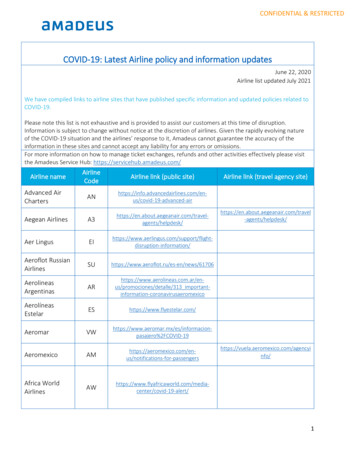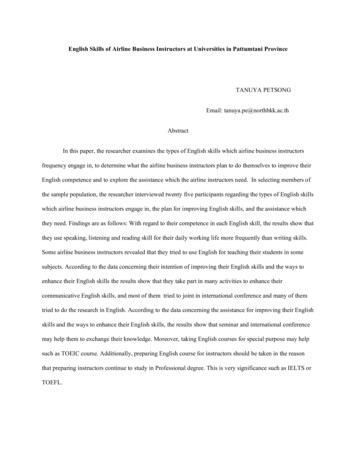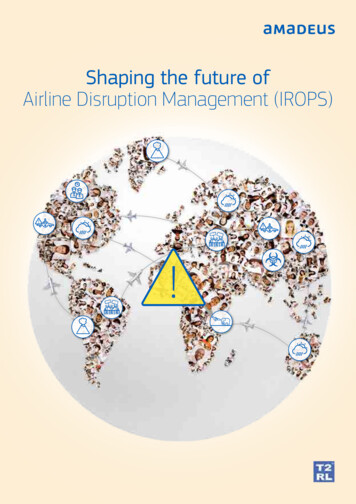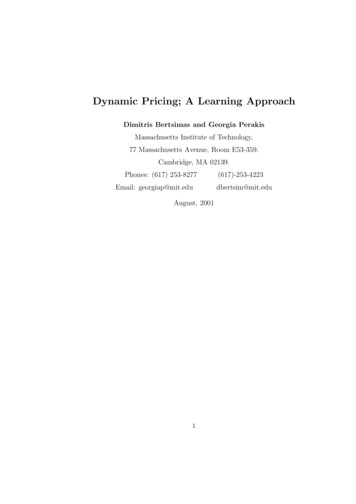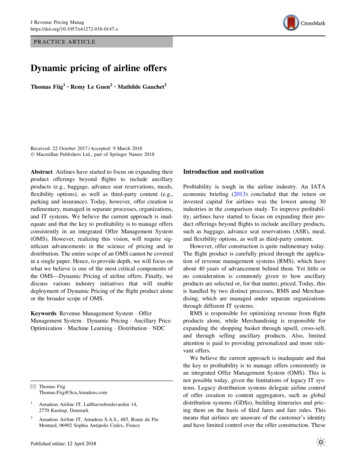
Transcription
J Revenue Pricing TICE ARTICLEDynamic pricing of airline offersThomas Fiig1 Remy Le Guen2 Mathilde Gauchet2Received: 22 October 2017 / Accepted: 9 March 2018 Macmillan Publishers Ltd., part of Springer Nature 2018Abstract Airlines have started to focus on expanding theirproduct offerings beyond flights to include ancillaryproducts (e.g., baggage, advance seat reservations, meals,flexibility options), as well as third-party content (e.g.,parking and insurance). Today, however, offer creation isrudimentary, managed in separate processes, organizations,and IT systems. We believe the current approach is inadequate and that the key to profitability is to manage offersconsistently in an integrated Offer Management System(OMS). However, realizing this vision, will require significant advancements in the science of pricing and indistribution. The entire scope of an OMS cannot be coveredin a single paper. Hence, to provide depth, we will focus onwhat we believe is one of the most critical components ofthe OMS—Dynamic Pricing of airline offers. Finally, wediscuss various industry initiatives that will enabledeployment of Dynamic Pricing of the flight product aloneor the broader scope of OMS.Keywords Revenue Management System OfferManagement System Dynamic Pricing Ancillary PriceOptimization Machine Learning Distribution NDC& Thomas FiigThomas.Fiig@Sca.Amadeus.com1Amadeus Airline IT, Lufthavnsboulevarden 14,2770 Kastrup, Denmark2Amadeus Airline IT, Amadeus S.A.S., 485, Route du PinMontard, 06902 Sophia Antipolis Cedex, FranceIntroduction and motivationProfitability is tough in the airline industry. An IATAeconomic briefing (2013) concluded that the return oninvested capital for airlines was the lowest among 30industries in the comparison study. To improve profitability, airlines have started to focus on expanding their product offerings beyond flights to include ancillary products,such as baggage, advance seat reservations (ASR), meal,and flexibility options, as well as third-party content.However, offer construction is quite rudimentary today.The flight product is carefully priced through the application of revenue management systems (RMS), which haveabout 40 years of advancement behind them. Yet little orno consideration is commonly given to how ancillaryproducts are selected or, for that matter, priced. Today, thisis handled by two distinct processes, RMS and Merchandising, which are managed under separate organizationsthrough different IT systems.RMS is responsible for optimizing revenue from flightproducts alone, while Merchandising is responsible forexpanding the shopping basket through upsell, cross-sell,and through selling ancillary products. Also, limitedattention is paid to providing personalized and more relevant offers.We believe the current approach is inadequate and thatthe key to profitability is to manage offers consistently inan integrated Offer Management System (OMS). This isnot possible today, given the limitations of legacy IT systems. Legacy distribution systems delegate airline controlof offer creation to content aggregators, such as globaldistribution systems (GDSs), building itineraries and pricing them on the basis of filed fares and fare rules. Thismeans that airlines are unaware of the customer’s identityand have limited control over the offer construction. These
T. Fiig et al.limitations prevent the airline industry from adoptingmodern e-commerce and enjoying its potential benefits(Popp 2016). At a more detailed level, these limitations aredescribed below.Description and limitations of existing RMSIncorrect view and valuation of the flight product In a shopping session, availability and pricing decisionsare for flights only. The value of ancillary products isdisregarded.Even considering flights only, a precise valuationwould require continuous prices. This is not possiblewith the 26 Reservation Booking Designator (RBD)based inventory logic that exists today.The net revenue received by the airline from selling aflight product is uncertain, as multiple fare productswith different fares are filed in the same RBD.Similar uncertainty exists with regard to interlineitineraries, the value of which is prorated acrossinterline partners according to special prorate agreements (SPAs). RMS neglects the variety and sophistication of SPAs, relying instead on approximations.Incorrect view of demand and willingness to pay Demand forecasting and pricing work in differentdimensions, leading to erroneous forecasting of demandand willingness to pay (WTP):––The RMS’ demand forecasting utilizes dimensionsto support control of the flight resources on thebasis of traffic flow, point of sale, and bookingclass.The airline’s pricing department utilizes dimensionsto support differentiation of a customer’s WTP,based on rules and restrictions such as customereligibility, return trip restrictions, minimum andmaximum stay durations, stopovers, Saturday andSunday night stay requirements, advance-purchaserestrictions, and combinability.No optimization of the total product offer The total set of products sold by the airline is neitheroptimized nor priced together, but independently.No personalization or merchandizing All customers receive the same price for the sameproducts. The sales display cannot be tailored to a customer in away that affects his or her purchase behavior.ContributionIn this paper we will formulate our vision for an OMS, anddiscuss how we may overcome many of the limitations thatexist today. However, the entire scope of an OMS cannotbe covered in a single paper. To provide depth, we willfocus on what we believe is one of the most critical components of an OMS—dynamic pricing (DP).Additionally, we discuss how the changing distributionlandscape, shaped by such initiatives as IATA’s NewDistribution Capability (NDC) and a global digital transformation, will dramatically influence the airline OMS.To our knowledge, no prior published work addressesthese questions, nor are we aware of any implementationthat includes dynamic pricing of airline offers.Organization of the paperThe paper is structured as follows: in Sect. ‘‘The OfferManagement System,’’ we define the airline offer, formulate our vision for the OMS, provide an overview of theOMS and its main components, and discuss the scientificchallenges of pricing a general airline offer. InSect. ‘‘Dynamic pricing of offers,’’ we discuss DP of airline offers, the underlying assumptions, and application toboth base and ancillary products. In Sect. ‘‘A distributionlandscape in motion,’’ we discuss various industry initiatives that will enable deployment of DP or the broaderOMS, the distribution channels and their interactions withthe OMS, and the technology required. In Sect. ‘‘Futureresearch directions,’’ we offer direction for future research,and finally in Sect. ‘‘Conclusion,’’ we provide ourconclusions.The Offer Management SystemDescription of an offerWe apply the following definition, in accordance withIATA (2016), ‘‘An offer is a proposal by an airline to acustomer for a defined set of products (flights and/or flightrelated or non-flight related ancillary products) in responseto a shopping request received from a seller, possibly viaan aggregator.’’ Shopping requests may be sent with individual traveler data (personalized) or sent without anyspecific traveler data (anonymous). The shopping responsemay be customized based on the traveler information that is
Dynamic pricing of airline offerspassed in the request (see also Sect. ‘‘Scientific challengesof pricing an offer’’).Offers may not be altered, nor can elements of one offerbe combined with elements of another offer. The offer willhave certain rules and conditions attached to it, for examplehow long the offer is valid for, by what time payment mustbe made, how long inventory is guaranteed for, etc.An offer consists of one or more offer items. An offeritem consists of two parts: a set of products1 and a price;bundled together in unity. The final property of the offeritem we would like to mention is its status, mandatory oroptional. During the shopping process an offer can becustomized by selecting/deselecting optional offer items.Consequently, the total offer price is computed by summing the selected offer items prices.To simplify the description of offers in this paper, wewill use the following terminology. We denote by productoffer and price offer; the sets of products and the prices ofthe constituting offer items, respectively. Finally we denotethe online processes that determine the product offer andprice offer, dynamic offer construction and dynamic pricing, respectively.Before we can understand the complexities of how todynamically price an offer, let us first consider a generalproduct offer.Product set of the airline offerFigure 1 illustrates a general airline offer composed ofmandatory and optional offer items. The individual productsets that make up the offer items are described below. Offeritems are marked by dashed boxes. The final offer may becustomized by selecting/deselecting among the optionaloffer items. Flight products—fare families with connecting flights(AL-FLT1, AL-FLT2): bundles consisting of flight seats,in-flight service, and privileges/ancillary products (freeof charge) attached with conditions and restrictions(shown as business, premium economy, and economyproducts).Hotel rooms—fare families with ‘‘connecting rooms’’(Hotel A—Day 1, Hotel A—Day 2): airlines’ own hotelproperties or third-party hotels (shown as sea-view andstreet-view).Interline flight connections (OAL-FLT).Base product—mandatory offer item that includes theflight product. One and only one of the flight products1The IATA (2016) terminology is set of services. The terms productand service seems to be used interchangeable in the airline industry.Hence to simplify the description of offers in this paper we will usethe term products to collectively describe products and services. (economy, premium economy, and business fare family) must be selected. Similarly for the hotel stay.Bundles of ancillaries—optional offer item targeted tospecific customer segments, such as a baggage pack(shown as carry-on bag, 1st bag, and 2nd bag) or aflexibility pack (shown as unlimited changes, namechange, or different itinerary). Other possibilities couldbe a comfort pack (not shown), consisting of priorityboarding, middle seat free, and/or ASR.Ancillaries offered a la carte—optional offer items(e.g., fare lock, cancelation, fast track, or priorityboarding), may be available only on an a la carte basis,while other ancillaries (e.g., carry-on bag, 1st bag, 2ndbag) may also be available as bundles.Third-party content—optional offer items (e.g., insurance, parking, hotels, rental car).Description of an Offer Management SystemVisionWe believe that: The OMS should dynamically construct and dynamically price offers, considering both customer andcontextual information.The distribution environment should provide channelconsistency with accurate content, built and controlledcentrally by the airline.Having a detailed view of the customer’s preferencesand WTP during the shopping session allow airlines todifferentiate among customers, thus making their offersmore relevant and improving the customer experience. Thiswill enable airlines to improve their revenue performance.Further, channel consistency will eliminate the confusionand mistrust that exist today among consumers about offertransparency.Components of the OMSThe business logic of OMS relies on five main modules—Content Management, Customer Segmentation, DynamicOffer Construction, Dynamic Pricing, and Merchandizing—that are briefly described below. Figure 2 shows howOMS processes an incoming shopping request througheach of these modules and responds with an offer (ormultiple offers). The DP component, which is highlightedin the figure, is the primary focus of this paper.Content management The objective of content management is to provide a catalog of the entire set of products(bundled and a la carte) that the airline can sell, as
PricecorrelationDyn. pricing ofbase offerBundled ancillaries(optional)Base product(mandatory)AL-FLT2AL-FLT1Hotel ADay 1BusinessHotel ADay 2BaggageCarry-onbagUnlimitedchanges1. bagNamechange2. bagDifferentitinerarySea viewPremiumEconomyPrice acrossmultiple FFFlexibilityOAL-FLTStreetviewEconomyInconsistent forecastand pricing dimensionsPrice mixedbundlesPrice across differentresource typesSparse dataDyn. pricing ofancillariesCustomerchoice modelsA la carte ancillaries(optional)Carry-onbag1. bag2. bagFare lockCancellationFast trackPriorityboardingASRExit seatLoungePrice of realoptionsPrice acrossmultiple resourcesT. Fiig et al.Meal3rd partyPrice3rd ntalcarFig. 1 Pricing challenges when pricing a general product offer. Red boxes indicate scientific issues to be overcome. Offer items indicated indashed boxes. Offer items can have mandatory or optimal statusesOffer Management ntentManagementDynamic PricingDynamic OfferConstructionFig. 2 Offer Management System (OMS). Shopping requests arepassed to the OMS. Offers are returned to the customerexplained above. We assume that the catalog is predefinedand that during the shopping flow, a product offer is constructed dynamically by selecting a set of products from thecatalog.Customer segmentation The underlying assumptionbehind customer segmentation is that we need to understand the customer’s behavior to construct appropriateoffers. This requires that existing and future customers canbe categorized into customer segments, based on suchshared characteristics as common needs, interests, lifestyles, or socio-demographics, past purchases, to name afew. Customer segmentation is performed offline, sharedwith other key functions in the airline, such as the digitaluser experience or servicing. A segmentation module mustalso consider cases when very little is known about thecustomer’s identity (e.g., an anonymous search), deducingthe customer’s travel purpose from the search context. Thecalibrated customer segmentation model is loaded intoOMS for online execution.Dynamic offer construction This module recommends themost relevant set of products in order to maximize theconversion of the shopping request at an individualized/customer segment level. Offer construction can beoptimized by recommender systems, which find broadapplication outside the airline industry (refer to thepioneering work by Linden (2003) or the recent textbookby Aggarwal (2016) for an overview of the field). Thecalibration of the models is performed offline and subsequently loaded into OMS for online execution. The modulehas several applications: Rank products from the product catalog, according torelevance.Bundle product sets to control the choice set availableto the customer.Propose upsell, cross-sell, and ancillaries withinshopping or re-shopping flows.Send unsolicited notifications (e.g., e-mail, mobile, orcheck-in kiosk) to customers to propose ancillaryproducts.
Dynamic pricing of airline offersDynamic pricing The DP module prices the product offerthat was constructed by the previous module. We willdetail this module in Sect. ‘‘Dynamic pricing of offers.’’Merchandizing From an RMS perspective, the airline isindifferent as to whether a customer accepts or rejects anoffer. The assumption is that once a fair market price is set,the airline is better off rejecting customers who will not paythe price because other customers will. The reasoningbeing that this sort of all-or-nothing course overall resultsin higher revenue for the airline. However, in reality, thecustomer’s purchasing behavior is neither rational norguided by utility maximization. Customers are humanswho can be affected by merchandising techniques.The purpose of the merchandizing module is to applymerchandizing techniques, such as framing (the way offersare presented), priming (influencing by focusing on specificattributes), defaults (preset options), decoys (adding inferior offers), or positioning (specific position in the ranking)to affect the customer’s purchasing behavior (Jannach et al.2010).b.c.d.Scientific challenges of pricing an offerSince the 1980s, airlines have relied on RMS to price flightproducts. Therefore, it is natural to consider whether RMSprinciples could be applied in OMS. Comparing theobjective of OMS against that of RMS (to maximize revenue by pricing flight products), there are two noteworthydifferences. First, while RMS optimizes only the price ofthe flight product (actually setting availabilities by bookingclass having pre-filed fares), OMS optimizes both constructing and pricing of the offer. This is a much moreambitious undertaking. Second, in contrast to RMS, whichprovides the same price to all customers having the sameitinerary and fare product, OMS may differentiate bothproducts and prices at an individualized level (so-calledpersonalized pricing). This practice may raise legal andmoral concerns, such as violations of perceived fairnessthat would have to be addressed (Reinartz 2002).Numerous challenges arise in moving toward theobjective of OMS. Solutions differ in terms of theirmaturity, which we group into three categories: mature (asatisfactory solution exists that has been implemented inRMS); emergent (new ideas or theories exist but solutionshave not been implemented); and immature (challengesthat remain unsolved despite much research effort).e.Emergent (new ideas)f.Mature (solved)a.Single resources The optimization of a single flight legdates back to Littlewood (1972), who solved theoptimization problem for two fare classes. Over theyears, this solution has been extended to multipleclasses (Belobaba 1989) and further to dynamic optimization (Lee and Hersh 1993; Lautenbacher andStidham 1999).Multiple resources Offers may consume multipleresources, such as a flight connection or a hotel staywith multiple nights. The offer, however, must beaccepted or rejected an entity. This means we cannotindependently optimize resources. This challenge wassolved in the early 1990s with the invention ofNetwork RMS (Smith and Penn 1988; Williamson1992).Fare family fare products The customer’s reservationprices for different fare products are correlated. Thismeans that prices cannot be determined for each fareproduct independently but must be determined simultaneously. This challenge was solved with the adventof fare adjustment theory (Fiig et al. 2010, 2011).Mix of different resource types Offers may include abundle with a mix of different types of resources, suchas a vacation package that includes a flight product anda hotel room. To manage this complexity, RM controlhas to apply additive bid prices across the differentresource types—a natural extension of bid-price control (Weber 2001).Third-party content pricing This is not a trivial issue,owing to complex SPA agreements for interlineconnections. For non-flight ancillary products, suchas hotels, insurance, or parking, various commercialmodels may apply either an agency model or amerchant model, each of which has unique revenuemaximization implications. However, the NDC standard proposes that an interline product is created as acontract between the offer responsible airline and itsinterline partner at the time of shopping (Hoyles 2015).From the perspective of the offer responsible airline,third parties can then be viewed as subcontractors andtheir prices treated as variable costs.g.Dynamic pricing of flight product The purpose of DP isto maximize contribution by dynamically pricing flightproducts, considering both customer and contextualinformation. In this regard, we can think of DP as alight version of OMS, with a narrow scope limited toflight products. Simulation studies by Fiig et al. (2015)have demonstrated that DP, by optimizing the contribution within the shopping session, can significantlyimprove revenue performance.Sparse-data issues in demand forecasting In networkRMS, demand forecasting is performed at the traffic
T. Fiig et al.h.i.j.flow/point-of-sale/fare product dimensions. At thislevel of detail, thick flows (C 10 passengers/year)account for only about 5% of all flows (Fiig 2007).Even when only thick flows are considered, datasparseness poses significant challenges (Gorin 2012;Fiig et al. 2014; Rauch et al. 2015, 2017). In OMS, theairline’s offer is expanded to contain multiple products—creating a need for an even finer level of detailand thereby aggravating the data-sparseness issue.Inconsistent forecast and pricing dimensions For theairline’s pricing department, the dimensions providedby demand forecasting are not detailed enough. Forthis reason, the pricing department utilizes its owndimensions by segmenting customers by eligibility andfare rules. The inconsistency between forecasting andpricing dimensions lead to erroneous demand andWTP forecasts. To resolve this issue, as well as thedata-sparseness issue, Rauch et al. (2015, 2017) proposed a groundbreaking idea of disentangling capacitycontrol from price optimization. We will return to thisconcept in the next section.Customer choice models To model individual customers’ decision-making processes, discrete choicemodels have been found to be superior to traditionalforecasting methodologies (Garrow 2010). Settingparameters for discrete choice models; however,requires information not only about the choice selected(as with traditional forecasting models) but also aboutthe alternatives not chosen. This information hastraditionally been difficult to obtain for the airlines,but technological advancements have made this moreaccessible now.Dynamic pricing of ancillary products Today, airlinesrely on static prices, filed in advance, for ancillaryproducts. Prices may differ by market, time todeparture, touch point, or sales channel but are notoptimized. As such, airlines miss a revenue opportunity. In this paper, we show how ancillary productsmay be dynamically priced in each shopping sessionusing price testing in conjunction with machinelearning (see Sect. ‘‘Dynamic pricing of ancillaries’’).Immature (unsolved)k.Mixed bundles Products can be sold as pure products (ala carte), bundles (sold as an entity), or a combinationof both (mixed bundles). This requires internal pricingconsistency, because the customer can select fromamong multiple offers containing the same (or similar)products. For example, the carry-on bag and check-inbags, sold both a la carte and as a bundle in Fig. 1,offers six options for the customer (no bags, onlyl.m.n.carry-on bag, one check-in bag, two check-in bags,carry-on bag and one check-in bag, baggage bundle).The concepts were formulated in a seminal paper byAdams and Yellen (1976)—yet despite decades ofresearch, no practical solution has been found.Correlated reservation prices Consumers’ reservationprices for different products may be correlated. Thismeans that prices cannot be determined for eachproduct independently but prices for all correlatedproducts must be determined simultaneously. Thisissue already exists in RMS in fare families and iscompounded when ancillaries are added because of themultitude of offers that can be constructed. Bockelie(2017) recently proposed a new dynamic programingapproach that explicitly accounts for ancillary productsand passenger choice behavior in RMS.Pricing of ticket options Airlines may offer derivativeproducts, such as ticket options (also called ‘‘time tothink’’ or ‘‘fare locks’’) that are equivalent to a calloption. This gives the customer the right—but not theobligation—to purchase the ticket within a givenwindow of time (such as 1 week) at a given price.Pricing ticket options, however, is significantly different than pricing financial options. We will not go intodetail here but refer the reader to our forthcomingpaper (Sahin forthcoming).Psychological factors The merchandizing techniquesdescribed above—framing, priming, defaults, decoy,positioning—influence human behavior. Muchresearch [notably, Kahneman and Tversky’s development of prospect theory (1979)] has been performed onbehavioral economics. However, psychological factorsso far have been difficult to model and consider in arigorous scientific way.Dynamic pricing of offersWe will assume that a product offer has been constructedand is ready to be priced. For this purpose, we need aprecise definition of the objective of dynamic pricing:Maximize contribution2 by dynamically pricing theproduct offer, considering both customer and contextualinformation.2Contribution is revenue less variable costs. Revenue Managementoften ignores the variable cost because the incremental cost of flyingone additional passenger was small. However, with lower ticket pricesand increasing fuel prices, landing fees, and taxes, this is no longertrue. Further, for third-party content, the cost component cannot beignored.
Dynamic pricing of airline offersAssumptionsDynamic pricing of the airline base product/flightcomponentWhen maximizing the contribution for a given shoppingrequest, we are evaluating the difference between thecontribution of selling the product now and the contribution of not selling the product (opportunity cost). Thisevaluation is made complex by the fact that the opportunitycost for an airline’s base product is non-zero, arising fromdemand pressure on the flight resources.For this reason, demand forecasts should be detailedenough—typically, at the levels of traffic flow, fare class,point of sale, departure day, and days to departure—toallow airlines to control their flight resources. Even thoughthis level of detail gives rise to significant data-sparsenessissues, it still is not detailed enough for pricing. Therefore,the airline’s pricing department utilizes their own dimensions, independent of RMS, on the basis of customerdimensions such as customer eligibility, minimum/maximum stay duration, stopover, combinability, round-triprestrictions, Saturday/Sunday restrictions, and advancepurchase restrictions, rules and restrictions—that differentiate customers’ WTP. This inconsistency results in RMSthat cannot accurately estimate or represent WTP along theflight resource dimensions.To resolve these issues, Rauch et al. (2015, 2017) proposed a groundbreaking idea: disentangle capacity controlfrom price optimization. Unlike traditional RMS, where asingle forecast is used to forecast both demand (input forthe optimizer that calculate bid prices [BP]) and WTP(input to the marginal revenue transformation that calculatefare modifiers [FM]), Rauch et al. propose splitting theforecast into two completely independent forecasts. Aprice-elasticity forecast used for price optimization (Fig. 3,left box), and a demand forecast used for capacity control(Fig. 3, right box).Capacity recastsPrices.non-priceattributesTo progress, we need to introduce some simplifyingassumptions. We will assume the notion of a fair marketprice, meaning that all customers in a given segmentreceive the same price for the same product offer. We willignore the complexities of mixed bundles, correlatedreservation prices, and psychological factors mentionedabove. In the Sect. ‘‘Future research directions,’’ we willdiscuss how we may relax these assumptions.With these simplifying assumptions, the task of dynamicpricing is essentially reduced to dynamically pricing ofindependent offer items: the airline base product and the ala carte ancillaries. This is described in the next twosections.Price PriceBookingsBid PricesDemandforecastDemandFig. 3 Disentanglement applied to dynamic pricingBased on this work, we now generalize the concept ofdisentanglement to enable Dynamic Pricing—one of theobjectives of OMS. Capacity control is managed by ademand forecast that determines volume and networkcontribution, which through optimization produces bidprices (as originally proposed by Rauch et al.). To achieveprice optimization, the price-elasticity forecasts must beextended to discrete choice models that consider the customer’s full choice set (during the shopping request)—notjust different booking classes of the traffic flow, as considered by RMS. In addition, the availability computationconsidered in RMS should be extended to take the generalchoice probabilities into account (see below).Calibration of choice modelsTo model an individual customer’s decision-making process, we apply discrete choice models. The data set forcalibrating the choice models is constructed by matchingbookings (from MIDT and PNRs from the airline’s reservation system) with the corresponding shopping context—acomprehensive list of alternatives available to the customerat time of booking. This provides a data set in which wehave, for each booked customer n, information about thealternatives i in their choice set i 2 Cn, including prices piand non-price attributes xni (vector notation). Typical nonprice attributes could be airline preference, time of daypreference, and schedule quality (e.g., number of stops ortrip duration).In practice, not all bookings can be traced and set intotheir shopping context. In addition, the choice set may beincomplete, because GDS-based search transactions do notalways capture information from all airlines (some airlinesdo not or only partially participate in GDS channels); nor
T. Fiig et al.do they capture information from other modes of transportation (e.g., rail or bus) that may be available to thecustomer.Despite these limitations, however, we are now in aposition to calibrate the selected choice model to obtainparameter estimates b and the choice probabilityPðijpi ; xni ; bÞ. The choice model parameters b typically arelinearly coupled to the attributes through the utility and assuch interpreted as sensitivity parameters.In pract
Management System,'' we define the airline offer, formu-late our vision for the OMS, provide an overview of the OMS and its main components, and discuss the scientific challenges of pricing a general airline offer. In Sect. ''Dynamic pricing of offers,'' we discuss DP of air-line offers, the underlying assumptions, and application to
